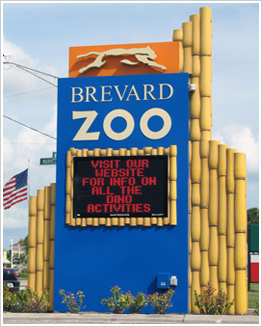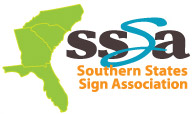Key Elements of Sign Design

The challenge all sign designers face in reaching those who live or work in a trade area is to make sure that after being seen repeatedly, the sign is still interesting enough to be remembered.
Visual Conspicuity
Before we address the importance of your sign's specific physical aspects, we must first address its conspicuity as a whole. Your business sign's conspicuity is something you need to keep in mind throughout the whole design and placement process. It is perhaps the most important aspect to retain during development.
Conspicuity, by definition, is the capacity of a sign to stand out or be distinguishable from its surroundings and thus be readily discovered by the eye. It is the perceptible distinction between a sign and its background, attributed to an exogenous (unplanned) or endogenous (planned) mindset, with the display having features that attract attention to the sign.
Conspicuity is considered a subjective outcome, meaning it is based on personal opinions, interpretations, points of view, emotions and judgment. That is exactly why it is basically impossible to create signage that is visually conspicuous to 100% of all potential customers. A person may pass by your sign and immediately notice it, and hopefully remember it, while others may drive right by without ever seeing the sign at all.
That is why it is crucial to make sure that your on premise sign stands out from its surroundings or background so that it is very noticeable, and naturally draws the potential customer's eye to it. Your sign may have all the right aspects, like size, height, color, illumination, placement, etc., in itself, but if you do not take into account the environment it will be placed in, that could result as a major loss of traffic to your storefront. Your sign, on its own, may be aesthetically pleasing and vivid, but once you place it in front of your business, where it has to compete with other signs, landscaping, utility features, traffic and street lights, and other environmental features, will it still be as noticeable?
There are two different types of conspicuity you will need to take into account when developing your storefront signage: search conspicuity and attention conspicuity. Search conspicuity has to do with whether or not a person is searching for a specific, or specific type of, business. Attention conspicuity has to do with your sign's ability to attract attention just by passing by, even when not looking for any particular business. A potential customer is more likely to notice a hardware store sign if they are specifically looking for tools than if they were just on their way to work. Proper signage will catch the attention of passing motorists, even when they may not be seeking that specific business it at the moment.
Visibility: Placement, Size & Height
While conspicuity is a more subjective aspect of proper sign design, visibility is considered an objective one. Meaning, visibility can be measured by whether or not the sign's physical attributes are discernible from an appropriate distance. You want passing motorists to have plenty of time to see the sign, determine its message, and react to it. Placement of your store's outdoor sign is the main contributing factor to its visibility, but other factors, such as size, height, illumination, also have a key impact.
Before you begin the process of placing your sign, you must first make sure that you are following all government regulations and restrictions in the local sign code. Then determine what a potential customer will see when approaching the sign's location to get an accurate perception of where the sign should be placed. Factors such as the layout and topography of the site can influence sign placement. You want to be sure passing motorists will have sufficient time to stop at your business once they see your sign.
You must also take into account a passing motorist's zone of awareness. Since a driver's view of the roadside is limited by their vehicle structure and attentiveness to the roadway, you need to make sure your sign will be in their line of sight. The farther a person has to turn their head to view the sign, the greater a sign's conspicuity is diminished. Concurrently, the vertical angle needs to be taken into account. Signs are typically viewed through a car windshield, so it is important to make sure your storefront sign is of satisfactory height. The father back from the road a sign is placed, the taller it can be. Also, the greater the distance you want the sign to be read at, for example on a highway, the taller you will want the sign to be.
Your signage should be, at the very least, capable of communicating effectively with potential customers that have 20/40 vision, not 20/20 vision, since most states have that as a requirement to obtain a driver's license. This can be especially critical to consider if your business is relevant to individuals with poor eyesight, such as an eyeglass store. Research has suggested that for every 25 feet of distance, 1 inch of letter height is needed, for people with 20/40 vision. Adequate sign size is also determined by the length of the business name or message. The smaller the sign, the less visible conspicuity, and therefore less value, it has.
Readability
Readability, a subjective outcome of signage, is the character of a sign that leads to comprehension of its intended message, with regards to legibility and a few other considerations. Since most potential customers are viewing your signage through their car windshield, they must be able to process the information within seconds so that they are able to decide whether or not they want to stop at your business, with ample time to move through traffic.
Cognitive recognition also plays a valuable role in readability. This can depend on the driver's psychological state, motivations, and familiarity with the sign's contents. If a passing motorist recognizes a familiar object, phrase or figure on the sign, then it will take them fewer glances to recognize and remember the sign, or business. Reducing the recognition time is the key to establishing a memorable sign. If the sign has too much information, is cluttered, or has too many colors going on, chances are passing motorists will look away and not attempt to comprehend the sign, since they are focused on the task of driving.
Visual aesthetics are also critical in the readability of your signage. Font, color, and graphics all affect whether or not someone decides to take another look at the sign. People will also create in their mind an idea, or opinion, of your business based on its signage. For example, certain colors let potential customers know what it is your business sells. For example, fast food companies typically use red as a main color in their signage, so someone looking for a fast food joint may not notice one that has a purple sign with lovely script font.
Legibility
Legibility, an objective stimulus, is the ability of the physical attributes of the sign that allow for differentiation between variables, and that directly relate to an observer's visual acuity, with respect to the distance that the sign is needed to be legible. Keep in mind the passing motorists will need sufficient time to read, comprehend, and react to the sign.
Your sign's legibility is dependent upon such variables as font, font size, spacing between letters or words, amount of blank area on the sign, and color contrast. Often times, a font that is more attractive than say a basic font, such as Times New Roman, is more difficult to read from the roadway than a more basic, block-like font. However, the nicer-looking fonts make your sign more unique, so to compensate for the lower readability you should create a larger sign, or larger lettering. It is also vital that the lettering stands out from its background. You want to have a highly visible color contrast, like red on black, or white on purple. If a sign's background is green and the lettering is blue, chances are it will not be very legible, especially to passing motorists that only have a few seconds to comprehend the sign's message.
Color
Color can be a highly influential visual cue. For instance, yellow is generally used to grab attention as it tends to create a feeling of optimism, whereas red is usually used to create a sense of urgency. Blue tends to create the sensation of trust and security, and green, which is associated with wealth, is the easier color for the eyes to process. However, these colors may have a different significance in foreign cultures, so you need to be aware of who your targeted customers are. Taking these things into account when designing your on premise sign can greatly affect the volume of customers generated from viewing your sign.
Illumination
Proper sign illumination has a drastic impact on the sign's appearance and effectiveness. It is of vital importance that your signage be noticed and comprehended properly. It also ensures that your sign is readable and visible at all hours of the day and night, and in most weather conditions. Proper illumination helps to establish better readability, resulting in a decrease of the time that potential customers need to process the information, therefore less time they are distracted from their task of driving. An illuminated sign also helps to promote your business after hours, or at night. People driving down the street at night, looking for a bar or club, may notice your sign and remember your business and its location for future purposes.
Architecture
The architecture of your sign can create certain visual elements that are beneficial to its noticeability. Your sign's architecture can help to make it stand out from its surroundings, like other signs, lights and landscaping. Your sign in itself can function as landscaping, being a sculptural element. You can design your signage to match your building or a specific theme. This can also help to enhance the areas standard of living, bringing about a positive impact on the local economy.



